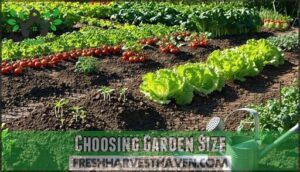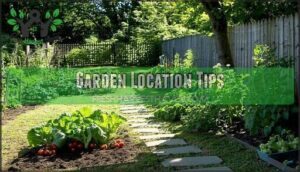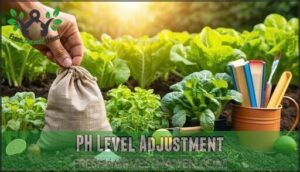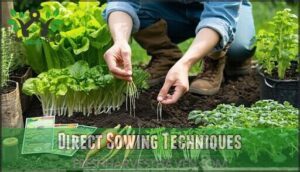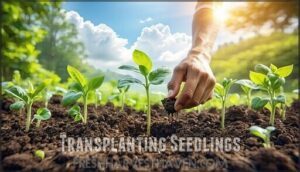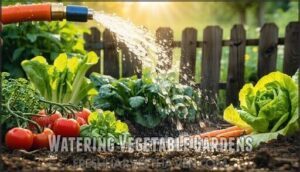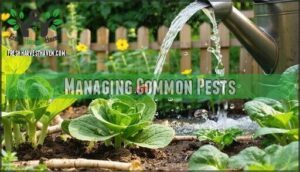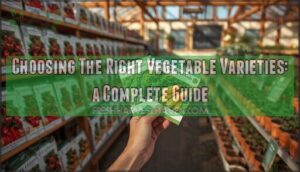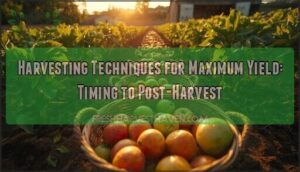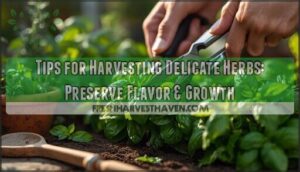This site is supported by our readers. We may earn a commission, at no cost to you, if you purchase through links.
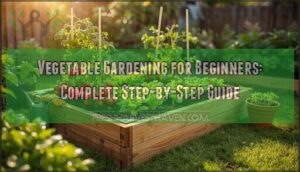 Starting vegetable gardening for beginners doesn’t require a green thumb—just smart choices and basic knowledge.
Starting vegetable gardening for beginners doesn’t require a green thumb—just smart choices and basic knowledge.
You’ll want to select easy-to-grow vegetables like lettuce, radishes, and tomatoes that forgive rookie mistakes while you learn the ropes.
Focus on finding a sunny spot with 6-8 hours of daily sunlight and well-draining soil enriched with compost.
Start small with containers or a modest 4×4 foot plot to avoid overwhelming yourself.
The secret lies in understanding your plants’ water needs, timing your plantings correctly, and recognizing common problems before they derail your harvest dreams.
Table Of Contents
- Key Takeaways
- Choosing Garden Size
- Selecting Vegetable Types
- Garden Location Tips
- Preparing Garden Soil
- Planting Vegetable Gardens
- Watering Vegetable Gardens
- Managing Common Pests
- Fertilizing Vegetable Gardens
- Harvesting Vegetables
- Maintaining Garden Health
- Frequently Asked Questions (FAQs)
- How to start a vegetable garden?
- What makes a good vegetable garden?
- What is the easiest vegetable garden for beginners?
- Is vegetable gardening for beginners a good idea?
- Is vegetable gardening a good hobby for beginners?
- How do I choose the right vegetables for my Garden?
- What is the easiest vegetable to grow for beginners?
- What is the most common mistake of first time gardeners?
- How should I arrange my vegetables in my garden?
- Which vegetables should not be planted next to each other?
- Conclusion
Key Takeaways
- Start small with a 4×4 foot raised bed – You’ll avoid overwhelming yourself while learning the basics and can easily manage watering, weeding, and harvesting tasks.
- Choose easy-to-grow vegetables like lettuce, radishes, and green beans – These forgiving crops mature quickly and won’t punish rookie mistakes while you’re building confidence.
- Focus on sunlight and soil preparation – You’ll need 6-8 hours of daily sun and well-draining soil enriched with compost for healthy plant growth.
- Water consistently and monitor for pests early – You’ll prevent most problems by maintaining steady soil moisture and catching issues before they damage your harvest.
Choosing Garden Size
You’ll need to decide on your garden size before you start planting, as this determines everything from seed quantities to maintenance time.
A well-planned garden size guarantees you can properly care for your plants while meeting your family’s vegetable needs without overwhelming yourself, which is a complete concept to consider for garden success.
Success starts with choosing the right garden size for your skill level and available time.
Small Garden Options
With limited space, you’ll discover container gardening and vertical gardens transform tiny areas into productive food sources.
A 4×4-foot raised bed or collection of containers works perfectly for beginners.
Try mini greenhouses on patios or balconies for year-round growing.
These space-saving solutions make urban farming accessible, letting you grow fresh vegetables anywhere, using vertical gardens.
Large Garden Plans
When you’re ready to expand beyond compact spaces, larger vegetable garden plans offer exciting possibilities for diverse crops and impressive harvests.
A 12×24-foot garden can feed a family of four with proper garden planning for beginners.
Smart garden layout includes paths every four feet for easy access and maintenance. Place tall plants northward to prevent shading shorter crops.
Effective crop rotation maintains soil health while maximizing yields. Consider soil testing before planting a vegetable garden to optimize nutrient levels.
Large plot gardening requires strategic garden design and quality garden tools for success.
Raised Bed Dimensions
Designing raised bed dimensions requires balancing accessibility with growing space.
Standard 4×4 or 4×8-foot raised bed materials create manageable bed size options for beginners.
These frame designs allow comfortable reach from all sides without stepping on soil.
Garden layout should maintain 18-24 inches between beds for easy movement.
Soil depth needs vary by crop – 6-8 inches suits herbs, while root vegetables require 12 inches minimum for proper development.
This consideration is crucial for the overall health and growing space of the plants.
Selecting Vegetable Types
Choosing the right vegetables sets your garden up for success from day one.
You’ll want to balance easy-to-grow varieties with crops your family actually enjoys eating, ensuring your gardening efforts translate into meals everyone will appreciate.
Easy to Grow Vegetables
For beginners, start with easy-to-grow vegetables that forgive mistakes and deliver quick results.
Radishes mature in just 30 days, while lettuce and baby greens can be harvested continuously. Bush beans and summer squash thrive with minimal care.
Focus on seed selection of reliable varieties, basic vegetable care, and simple garden tools. These beginner gardening guide staples build confidence for your vegetable gardening journey.
To increase the chances of a successful harvest, consider easy gardening tips when planning your garden, and remember to follow basic vegetable care for the best results with reliable varieties.
Family Favorite Vegetables
Your family’s vegetable preferences should guide your garden planning. Don’t waste time growing brussels sprouts if everyone turns up their nose at dinner. Instead, focus on vegetables that’ll actually make it from garden to plate with enthusiasm.
Smart gardening means growing what your family actually eats—fresh vegetables that go from garden to dinner table with zero complaints.
Consider these family-friendly approaches for your vegetable gardening for beginners journey:
- Survey your crew – Ask what vegetables everyone genuinely enjoys eating before planting
- Think beyond salads – Include vegetables that work in family recipes like pasta sauces and stir-fries
- Plan for meal planning – Grow staples that appear regularly in your weekly menu rotation
- Enable harvest sharing – Plant enough to share garden delights with neighbors and friends
- Start small – Begin with 3-4 family favorites rather than overwhelming yourself with variety
Nutrient Rich Vegetables
Beyond taste preferences, you’ll want to maximize your garden’s nutritional punch.
Smart vegetable choices deliver essential vitamins, minerals, and antioxidants that support your family’s health while providing excellent value from your growing efforts.
| Vegetable | Key Nutrients | Health Benefits | Growing Tips |
|---|---|---|---|
| Spinach | Iron, Vitamin K, Folate | Bone health, blood formation | Grows in partial shade |
| Sweet Potatoes | Beta-carotene, Fiber | Eye health, digestion | Needs warm, loose soil |
| Kale | Vitamin C, Calcium | Immune support, bones | Cold-hardy, easy care |
| Carrots | Vitamin A, Potassium | Vision, heart health | Deep, sandy soil preferred |
Choose vegetables with high nutrient density to get the most bang for your buck.
Dark leafy greens, colorful root vegetables, and cruciferous crops pack serious nutritional firepower.
These powerhouses thrive in nutrient-rich soil enhanced with organic matter, making your organic gardening efforts pay dividends in both flavor and health benefits.
Garden Location Tips
Your garden’s location will make or break your vegetable growing success.
You’ll need to examine three critical factors: sunlight exposure, soil drainage, and wind protection to create the ideal growing environment.
Sunlight Requirements
Understanding your garden’s daily sun hours is essential for vegetable success. Most vegetables need 6-8 hours of direct sunlight, but some adapt to afternoon shade conditions.
Here’s what you need to know about sunlight intensity and shade tolerance:
- Full sun vegetables (tomatoes, peppers, beans) require 8-10 hours of morning sun and consistent sunlight intensity
- Partial shade crops (lettuce, spinach, kale) thrive with 4-5 hours of morning sun plus afternoon shade
- Shade-tolerant greens (arugula, Asian greens) manage with just 2-4 hours of filtered sunlight
- Raisedbed gardens often receive better sun exposure than ground-level plots due to elevation
Track your yard’s sun patterns throughout the day to identify the best spots. This observation helps you match each vegetable’s needs to the right location, ensuring your watering plan and soil test efforts pay off with healthy, productive plants.
Soil Quality Assessment
Before the shovel hits the ground, you’ll want to know what lies beneath your feet.
A soil test reveals vital information about pH balance, nutrient levels, and soil structure that determines your garden’s success.
Test soil from 6-12 spots across your planned garden area for accurate results.
This simple step prevents costly mistakes and guarantees your vegetables get the nutrient-rich soil they need to thrive.
Understanding soil health metrics is key to creating a fertile ground for your garden.
Wind Protection Methods
Strong winds can devastate tender seedlings and reduce yields substantially.
Install windbreaks using fence installation techniques or snow fencing around your garden’s perimeter. Row covers provide excellent plant shields for individual beds, while strategically placed shrubs create natural wind protection.
These garden protection methods are essential gardening tips for beginners practicing vegetable gardening for beginners, ensuring proper garden care throughout the growing season.
Preparing Garden Soil
Your garden’s success starts with healthy soil that feeds your plants from the ground up.
Before planting, you’ll need to transform your dirt into a nutrient-rich foundation by adding organic matter, improving drainage, and adjusting pH levels for ideal plant growth.
Adding Organic Matter
Your garden’s success depends on feeding the soil first—plants will follow. Organic matter transforms lifeless dirt into nutrient-rich soil that supports healthy vegetables. Smart gardeners know that soil amendments create the foundation for thriving plants.
Here’s what you’ll need for organic gardening tips:
- Compost Types: Kitchen scraps, yard waste, or store-bought compost add slow-release nutrients
- Aged Manure: Well-composted cow or chicken manure provides nitrogen and improves texture
- Leaf Mold: Decomposed leaves create excellent soil structure and water retention
- Organic Fertilizers: Fish emulsion or bone meal supplement natural nutrients
- Mulch Benefits: Grass clippings or shredded leaves feed soil while conserving moisture
Work these garden soil amendments into your planting area 2-4 weeks before sowing seeds. This gives materials time to integrate and stabilize soil pH naturally. Understanding soil health basics is essential for creating a thriving garden ecosystem.
Improving Soil Structure
Good soil structure acts like a well-organized apartment building for roots—plenty of space, proper ventilation, and easy access to resources.
Focus on soil aeration through gentle tilling and compost addition to create loose, crumbly texture. Add organic matter like aged manure or leaf mold to improve drainage and nutrient-rich soil development.
These soil amendments enhance water infiltration while maintaining soil nutrients for healthy plant growth. Effective soil aeration tools, such as those using soil aeration methods, can also improve soil structure and promote healthy root development.
PH Level Adjustment
Testing soil pH reveals your garden’s potential by revealing nutrient availability secrets.
Most vegetables thrive in soil conditions between 6.0-7.0 pH, where nutrient management becomes effortless.
Soil testing determines whether you need acidic solutions or alkaline adjustments.
Apply lime to raise pH or sulfur to lower it during soil preparation.
Proper PH balancing creates nutrient-rich soil that transforms ordinary plots into productive gardens.
Planting Vegetable Gardens
You’re ready to put your plants in the ground and watch your garden come to life.
This critical step requires proper timing, technique, and understanding of how different plants work together to create a thriving vegetable garden.
The understanding of how different plants work together is key to creating a thriving vegetable garden.
Direct Sowing Techniques
Once you’ve prepared nutrient-rich soil, planting your garden seeds directly into the ground offers several advantages.
Direct sowing eliminates transplant shock while allowing root systems to develop naturally. Many vegetables actually prefer this method, especially those with sensitive taproots like carrots and beans.
Here’s your direct sowing game plan:
- Seed Selection: Choose high-quality garden seeds designed for your growing zone and climate conditions
- Sowing Depths: Plant seeds at depths roughly 2-3 times their diameter for ideal germination rates
- Soil Temperature: Check that soil reaches appropriate temperatures – cool-season crops need 45-65°F, warm-season crops require 65-75°F
- Direct Seeding Spacing: Follow packet instructions for proper spacing to prevent overcrowding and competition for nutrients
Starting seeds directly in your garden beds gives you complete control over the growing process from day one.
Transplanting Seedlings
Success begins with selecting healthy seedlings and timing your transplant perfectly.
Wait until nighttime temperatures consistently stay above 50°F for warm-season crops like tomatoes and peppers.
Before transplanting seedlings, start the hardening off process by gradually exposing them to outdoor conditions over 7-10 days.
This seedling hardening prevents transplant shock and promotes strong root development.
Choose cloudy days for transplanting to reduce stress.
Dig holes slightly larger than root balls, ensuring proper soil acclimation through gentle watering after planting, which aids in strong root development.
Companion Planting Benefits
Once you’ve mastered transplanting seedlings, companion planting becomes your secret weapon for garden harmony.
This strategic approach pairs plants that naturally support each other, creating a thriving ecosystem that benefits your entire vegetable garden.
Here’s how companion planting transforms your garden:
- Natural pest control – Marigolds repel aphids while basil deters tomato hornworms
- Soil enrichment – Legumes fix nitrogen for heavy feeders like corn and squash
- Space optimization – Lettuce grows beneath tall tomato plants, maximizing garden real estate
Smart companion planting reduces your workload while boosting yields.
Plant diversity creates natural balance, minimizing pest problems without chemicals.
This gardening tip works especially well for beginners seeking easy gardening ideas that deliver impressive results through crop rotation and thoughtful plant partnerships.
Watering Vegetable Gardens
Water serves as the lifeblood of your vegetable garden, making proper irrigation techniques essential for healthy plant growth and maximum yields.
You’ll need to understand each plant’s specific water requirements and implement efficient watering methods to avoid both drought stress and waterlogged roots that can kill your crops, which is crucial for healthy plant growth.
Understanding Water Requirements
Different vegetables have varying water requirements based on their growth stage and type.
Most vegetables need 1-2 inches of water weekly, but leafy greens require less while fruiting crops like tomatoes need more.
Soil moisture should remain consistent – check by inserting your finger 2 inches deep.
Water conservation through efficient garden watering prevents waste and promotes healthy root development in your plants, which is essential for water conservation.
Efficient Irrigation Methods
Smart watering systems can transform your vegetable gardening for beginners experience.
Drip irrigation delivers water directly to roots, reducing usage by 60% while doubling yields.
Soaker hoses provide gentle, even watering perfect for raised beds.
Automated systems with timers maintain consistent soil moisture without daily effort.
These water conservation methods keep your garden thriving while minimizing waste and labor.
Effective deep watering techniques are essential for promoting healthy root development and maximizing yields, using methods like drip irrigation and soaker hoses for water conservation and automated systems.
Mulching for Moisture
Mulch acts as your garden’s moisture-saving blanket, reducing watering frequency while keeping soil consistently damp.
Apply a 2-3 inch layer around plants, leaving space near stems to prevent rot.
- Organic Mulch: Straw, grass clippings, or shredded leaves decompose slowly, adding soil nutrients
- Soil Retention: Prevents evaporation and maintains steady moisture levels during hot weather
- Water Conservation: Reduces watering needs by up to 50% in vegetable gardening for beginners
Managing Common Pests
Even healthy gardens can attract unwanted visitors that threaten your harvest. Regular monitoring and early intervention help you catch pest problems before they cause serious damage to your plants.
Identifying Garden Pests
Spotting garden pests early prevents major damage to your vegetable crops.
Conduct regular pest inspection by examining leaves, stems, and soil for signs like chewed holes, wilting, or discoloration.
Look for actual bugs, egg clusters, and sticky residue.
Garden monitoring should include checking for beneficial bugs too—ladybugs and spiders help with pest control.
Proper pest identification guides effective pest prevention strategies for garden pests for beginners.
Natural Pest Control Methods
Natural pest control methods work like a well-orchestrated symphony in your garden.
Companion planting with herbs like basil and marigolds repels harmful insects while attracting beneficial bugs.
Organic sprays containing neem oil or garlic provide gentle yet effective protection.
Crop rotation confuses pests, while pest traps and biological control agents like ladybugs maintain nature’s balance without harming beneficial pollinators.
Preventing Plant Diseases
Prevention beats treatment when managing garden diseases. Choose Disease Resistance varieties whenever possible—they’re your first line of defense against common plant diseases.
Practice Crop Rotation annually to break disease cycles that overwinter in soil. Maintain Soil Sanitation by removing infected plant debris immediately.
Space plants properly for air circulation, reducing Fungal Control issues. Water at soil level to prevent Bacterial Management problems.
These simple practices keep your vegetable garden care routine manageable for beginners.
Fertilizing Vegetable Gardens
You’ll give your plants the right nutrients at the right time when you understand their feeding needs throughout the growing season.
Proper fertilization turns struggling seedlings into productive plants that’ll reward you with abundant harvests all season long.
Nutrient Requirements
During your garden’s growing season, plants need three primary nutrients: nitrogen for leafy growth, phosphorus for root development, and potassium for disease resistance.
Soil testing reveals existing nutrient levels, guiding your fertilization strategy.
Through crop rotation and organic matter incorporation, you’ll establish nutrient cycling that supports nutrient-rich soil.
Proper nutrient management guarantees the best garden fertilization for thriving vegetables.
Choosing Fertilizer Type
When choosing between organic fertilizers and synthetic options, you’ll discover the secret to nutrient-rich soil that transforms your vegetable gardening basics.
Organic matter like compost tea creates thriving ecosystems, while synthetic fertilizers deliver quick results for garden soil for beginners.
Consider these game-changing options for gardening for beginners:
- Organic fertilizers – Build long-term soil health with fish meal and kelp
- Synthetic options – Provide immediate nutrient boosts for quick corrections
- Compost tea – Enhance microbial activity naturally
- Foliar sprays – Deliver nutrients directly through leaves
Using organic fertilizer sources can help you make informed decisions about soil nutrition.
Application Timing and Methods
Perfect timing trumps perfect fertilizer every time—applying nutrients when your plants can actually use them maximizes both uptake and your garden’s potential.
Most vegetables need feeding at transplanting, mid-season, and during heavy fruiting periods.
| Growth Stage | Timing & Method |
|---|---|
| Seedling/Transplant | Apply balanced fertilizer at planting; work into soil 2-3 inches deep |
| Vegetative Growth | Side-dress nitrogen-rich fertilizer 4-6 weeks after seed germination |
| Flowering/Fruiting | Switch to phosphorus-heavy fertilizer when first flowers appear |
| Heavy Producers | Feed tomatoes, peppers weekly; follow your planting schedule for timing |
| Root Vegetables | Light feeding only—excess nitrogen creates leafy tops, small roots |
Early morning application works best since plants absorb nutrients most efficiently then.
Water thoroughly after fertilizer application to activate soil nutrients and prevent root burn.
Harvesting Vegetables
You’ve reached the rewarding moment when your garden’s hard work pays off with fresh, flavorful vegetables ready for your table.
Knowing when and how to harvest properly guarantees you’ll enjoy peak taste and nutrition while encouraging continued production from your plants, which is crucial for continued production.
Determining Harvest Time
Many gardeners struggle with harvest timing, but watching for visual cues makes all the difference.
Check for color changes—tomatoes shift from green to deep red, while watermelons develop creamy yellow undersides. Feel for firmness; ripe tomatoes yield slightly to pressure but spring back.
Size matters too—carrots show orange shoulders when ready, and beets reach peak tenderness at 2-3 inches diameter.
Morning harvests preserve freshness best. Understanding peak ripeness signs is essential for a successful harvest.
Proper Harvesting Techniques
Use sharp, clean tools for harvesting vegetables to prevent plant damage and disease transmission.
Cut stems rather than pulling to avoid root disturbance. Harvest during cool morning hours when plants are fully hydrated for peak freshness.
Handle produce gently to prevent bruising and maintain quality. Time your picking based on each vegetable’s maturity indicators for maximum flavor and nutritional value. Use sharp tools to ensure a clean cut.
Handling and Storing Harvest
After harvesting, handle your vegetables gently to prevent bruising and maintain maximum harvest yield.
Cool produce immediately in cold water or refrigerate within two hours for food safety.
Store different vegetables according to their specific needs – root vegetables in cool, dark places, leafy greens in perforated bags.
Proper Fresh Handling and Crop Storage techniques extend shelf life substantially, using methods such as Cool storage to keep vegetables fresh.
Maintaining Garden Health
A healthy garden requires thoughtful planning and consistent maintenance to produce the best vegetables year after year.
You’ll need to establish proper pathways, maintain soil quality, and implement practices that keep your garden thriving through multiple growing seasons, which involves consistent maintenance.
Garden Layout Considerations
Smart garden layout planning sets the foundation for your vegetable garden’s success.
You’ll maximize space, improve plant health, and simplify maintenance with strategic design choices.
Consider these essential spatial planning elements:
- Crop Rotation: Map out four-year rotation cycles to prevent soil depletion and disease buildup
- Bed Arrangement: Design 4-foot-wide beds for easy reach from both sides without soil compaction
- Garden Paths: Create 18-24 inch walkways between beds for comfortable access and wheelbarrow movement
- Soil Mapping: Document sun exposure, drainage patterns, and soil quality variations across your space
- Small Garden Ideas: Utilize vertical growing and succession planting to maximize limited square footage
Your vegetable garden design should accommodate future expansion while maintaining efficient workflow patterns throughout growing seasons.
Access Paths and Bed Maintenance
Design garden paths every 4 feet using gravel, mulch, or stepping stones as path materials.
Install bed edging to prevent soil compaction from foot traffic.
Keep paths narrow but accessible for wheelbarrows and maintenance tools.
Regular weeding along pathways prevents competition with your crops.
Well-planned garden accessibility reduces damage to raised beds during routine garden maintenance tasks.
Continuous Garden Improvement
Everyone knows that creating a thriving garden requires ongoing refinement.
Smart gardeners embrace continuous improvement through systematic tracking and seasonal adjustments. Your garden’s evolution depends on consistent evaluation and strategic planning for long-term success.
- Garden Records: Track planting dates, yields, and pest issues for data-driven decisions
- Crop Rotation: Rotate plant families every 3-4 years to maintain soil health
- Soil Testing: Test pH and nutrients annually to optimize growing conditions
- Seasonal Planning: Plan succession plantings and cover crops for year-round productivity
- Garden Renewal: Add compost, mulch, and beneficial amendments each season
Frequently Asked Questions (FAQs)
How to start a vegetable garden?
You’d think digging in dirt would be complicated, but it’s surprisingly simple.
Choose a sunny spot with well-draining soil, start small with a 4×4 raised bed, and select easy vegetables like lettuce and radishes for guaranteed success.
What makes a good vegetable garden?
A good vegetable garden needs well-draining soil, 6-8 hours of sunlight daily, and proper spacing.
You’ll want easy access for maintenance, quality seeds, and realistic planning based on what your family actually eats regularly.
What is the easiest vegetable garden for beginners?
Like planting seeds in fertile soil, your beginner garden starts with a simple 4×4-foot raised bed.
You’ll need easy crops like lettuce, radishes, and green beans that practically grow themselves with minimal fuss.
Is vegetable gardening for beginners a good idea?
Vegetable gardening absolutely works for beginners. You’ll gain confidence with easy crops like lettuce and radishes while enjoying fresh produce. Start small with a 4×4 raised bed for manageable success.
Is vegetable gardening a good hobby for beginners?
Yes, you’ll find vegetable gardening rewarding and manageable as a beginner.
Start small with easy crops like lettuce and radishes, then expand your skills and garden size as you gain confidence and experience.
How do I choose the right vegetables for my Garden?
Which vegetables will actually thrive in your specific growing conditions?
Choose easy-to-grow options like lettuce, green beans, and radishes first.
Consider your family’s preferences, consumption patterns, and prioritize vegetables that taste superior when homegrown, like tomatoes.
What is the easiest vegetable to grow for beginners?
Lettuce, radishes, and green beans are your best starting vegetables. They’re nearly foolproof, grow quickly, and won’t overwhelm you with complicated care requirements while you’re learning the gardening ropes.
What is the most common mistake of first time gardeners?
Overwatering destroys more gardens than drought ever could.
You’re drowning your plants’ roots, creating perfect conditions for fungal diseases and root rot that’ll kill your precious seedlings faster than you can say "green thumb.
How should I arrange my vegetables in my garden?
Place tall plants like tomatoes on the north side to prevent shading shorter crops.
Group plants by nutrient needs and growth habits.
Include paths every four feet for easy access during maintenance and harvesting.
Which vegetables should not be planted next to each other?
Coincidentally, companion planting affects more than just growth—it determines survival.
Don’t plant tomatoes near black walnut trees, beans beside onions, or fennel anywhere near vegetables.
These combinations create chemical warfare, stunting growth and reducing yields through allelopathy and nutrient competition.
Conclusion
Your garden journey transforms from overwhelming dream to productive reality through deliberate steps and patient observation.
Success in vegetable gardening for beginners depends on starting small, choosing appropriate varieties, and learning through hands-on experience.
You’ll discover that consistent watering, proper soil preparation, and pest management become second nature with practice.
Each season builds your confidence and knowledge base, and remember, every expert gardener started exactly where you’re now—with curiosity and determination to grow their own food, leading to a journey of patient observation.

